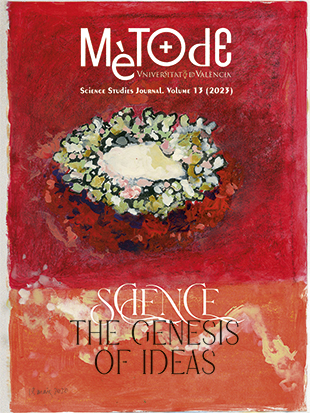Belleza y elección de pareja: Lo que la biología evolutiva nos enseña
DOI:
https://doi.org/10.7203/metode.13.24205Palabras clave:
belleza, elección de pareja, evolución, psicología evolucionista, selección sexual Resumen
Resumen
Tendemos a considerar la belleza como el producto destilado de nuestra educación, la quintaesencia de nuestro refinamiento cultural. Además, a menudo destacamos el relativismo de la belleza. Por este motivo, muchos encuentran chocante que la percepción de la belleza, especialmente la belleza humana, tenga una clara explicación biológica, en gran medida independiente de nuestra educación y de nuestra cultura, y les sorprende descubrir que las características que definen la belleza no solo tienen sentido biológico, sino que además son universales, comunes a todos los miembros de nuestra especie.
 Descargas
Descargas
 Citas
Citas
Bovet, J., & Raymond, M. (2015). Preferred women’s waist-to-hip ratio variation over the last 2,500 years. PLOS ONE, 10(4), e0123284. https://doi.org/10.1371/journal.pone.0123284
Buss, D. (2016). The evolution of desire: Strategies of human mating. Basic Books.
Cloud, J. M., & Perilloux, C. (2014). Bodily attractiveness as a window to women’s fertility and reproductive value. In V. A. Weekes-Shackelford & T. K. Shackelford (Eds.), Evolutionary perspectives on human sexual psychology and behavior (pp. 135–152). Springer. https://doi.org/10.1007/978-1-4939-0314-6_7
Coetzee, V., Greeff, J. M., Stephen, I. D., & Perrett, D. I. (2014). Cross-cultural agreement in facial attractiveness preferences: The role of ethnicity and gender. PLOS ONE, 9(7), e99629. https://doi.org/10.1371/journal.pone.0099629
Cunningham, M. R., Roberts, A. R., Wu, C. H., Barbee, A. P., & Druen, P. B. (1995). “Their ideas of beauty are, on the whole, the same as ours”: Consistency and variability in the cross-cultural perception of female attractiveness. Journal of Personality and Social Psychology, 68(2), 261–279. https://doi.org/10.1037/0022-3514.68.2.261
Darwin, C. (1871). The descent of man and selection in relation to sex. Murray.
Etcoff, N. (1999). Survival of the prettiest: The science of beauty. Anchor Books.
Font, E., & Carazo, P. (2021). False dichotomies and human sexual size dimorphism: A comment of Dunsworth (2020). Evolution and Human Behavior, 42(2), 176–178. https://doi.org/10.1016/j.evolhumbehav.2020.08.003
Grammer, K., Fink, B., Møller, A. P., & Thornhill, R. (2003). Darwinian aesthetics: Sexual selection and the biology of beauty. Biological Reviews, 78(3), 385–407. https://doi.org/10.1017/s1464793102006085
Kenrick, D. T., Keefe, R. C., Bryan, A., Barr, A., & Brown, S. (1995). Age preferences and mate choice among homosexuals and heterosexuals: A case for modular psychological mechanisms. Journal of Personality and Social Psychology, 69(6), 1166–1172. https://doi.org/10.1037/0022-3514.69.6.1166
Langlois, J. H., Kalakanis, L., Rubenstein, A. J., Larson, A., Hallam, M., & Smoot, M. (2000). Maxims or myths of beauty? A meta-analytic and theoretical review. Psychological Bulletin, 126(3), 390–423. https://doi.org/10.1037/0033-2909.126.3.390
Langlois, J. H., Ritter, J. M., Roggman, L. A., & Vaughn, L. S. (1991). Facial diversity and infant preferences for attractive faces. Developmental Psychology, 27(1), 79–84. https://doi.org/10.1037/0012-1649.27.1.79
Miller, G. F. (2000). The mating mind: How sexual choice shaped the evolution of human nature. Vintage.
Muller, M. N., Thompson, M. E., & Wrangham, R. W. (2006). Male chimpanzees prefer mating with old females. Current Biology, 16(22), 2234–2238. https://doi.org/10.1016/j.cub.2006.09.042
Singh D., Dixson B. J., Jessop T. S., Morgan B., & Dixson A. F. (2010). Cross-cultural consensus for waist–hip ratio and women’s attractiveness. Evolution and Human Behavior, 31(3), 176–181. https://doi.org/10.1016/j.evolhumbehav.2009.09.001
Singh, D. (1993). Adaptive significance of female physical attractiveness: Role of waist-to-hip ratio. Journal of Personality and Social Psychology, 65(2), 293–307. https://doi.org/10.1037//0022-3514.65.2.293
Singh, D., & Singh, D. (2011). Shape and significance of feminine beauty: An evolutionary perspective. Sex Roles, 64, 723–731. https://doi.org/10.1007/s11199-011-9938-z
Singh, D., Renn, P., & Singh, A. (2007). Did the perils of abdominal obesity affect the depiction of female beauty in the sixteeth to eighteenth century British literature? Exploring the health and beauty link. Proceedings of the Royal Society of London B, 274(1611), 891–894. https://doi.org/10.1098/rspb.2006.0239
Stewart-Williams, S., & Thomas, A. G. (2013). The ape that thought it was a peacock: Does evolutionary psychology exaggerate human sex differences? Psychological Inquiry, 24(3), 137–168. https://doi.org/10.1080/1047840X.2013.804899
Symons, D. (1995). Beauty is in the adaptations of the beholder: The evolutionary psychology of human female sexual attractiveness. In P. R. Abramson & S. D. Pinkerton (Eds.), Sexual nature, sexual culture (pp. 80–119). The University of Chicago Press.
Trivers, R. L. (1972). Parental investment and sexual selection. In B. Campbell (Ed.), Sexual selection and the descent of man 1871-1971 (pp. 139–179). Aldine Publishing Company.
Descargas
Publicado
Cómo citar
-
Resumen1659
-
PDF 661
Número
Sección
Licencia
![]()
Todos los documentos incluidos en OJS son de acceso libre y propiedad de sus autores.
Los autores que publican en esta revista están de acuerdo con los siguientes términos:
- Los autores conservan los derechos de autor y garantizan a Metode Science Studies Journal el derecho a la primera publicación del trabajo, licenciado bajo una licencia de Creative Commons Reconocimiento-NoComercial-SinObraDerivada 4.0 Internacional, que permite a otros compartir el trabajo con un reconocimiento de la autoría del trabajo y citando la publicación inicial en esta revista.
- Se permite y se anima a los autores a difundir sus trabajos electrónicamente a través de páginas personales e institucionales (repositorios institucionales, páginas web personales o perfiles a redes profesionales o académicas) una vez publicado el trabajo.





